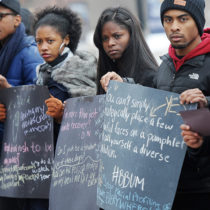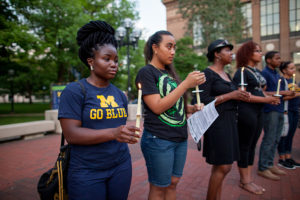Magazine

Being Black at U-M
A declining minority enrollment rate at U-M. Nationwide police shootings of unarmed black men. White nationalists on campus and a rise in hate crimes. These injustices and more awoke a social movement at Michigan and beyond. At the center of it was Austin McCoy, whose newly archived collection of activism materials tells a story that is still ongoing.
by Katie Vloet
“Remember, we are bigger than the white supremacists.”
That was Austin McCoy’s message in 2016 to like-minded students, faculty, and community members who wanted to join him in fighting racism that was sprouting up on campus in the form of speeches, fliers, and threats.
But remember to be safe, he cautioned. “You can tear down the posters. . . .Take a picture of the poster(s) for your records and report it. . . .Be careful tearing down as some white supremacists have been known to rig them with harmful objects. Have some gloves on hand.”
McCoy’s notes about how to combat these very public displays of racism are now at the Bentley Historical Library, a collection of his activism while he was a Ph.D. student and postdoctoral fellow at U-M. In that time, he was one of the leaders of the United Coalition for Racial Justice (UCRJ) and Being Black at the University of Michigan (#BBUM) and organized the 2014 Speak Out for Racial Justice, which was attended by more than 1,000 people.
Even before attending U-M, he knew that issues of racial justice were simmering just beneath the surface in Ann Arbor. And when he visited before deciding where to go for his history Ph.D. studies, black graduate students told him about declines in the minority enrollment at U-M and a feeling of being marginalized. Yet his activism did not begin the moment he set foot on campus in 2009. “I didn’t start doing activist work until my fourth year,” he said in one of his many campus speeches, the text and notes for which are included in his papers at the Bentley. “I wanted to when I first started my Ph.D. work, but I took my first few years to focus on completing my requirements. Then Trayvon Martin happened,” he said.
An Activist Gets Active
In February 2012, a neighborhood watch coordinator in a Florida gated community fatally shot 17-year-old high school junior Trayvon Martin. The young African American man was visiting relatives at the time. He was unarmed. The shooter was charged with murder, but, a year and a half after the shooting, a jury found him not guilty, prompting outrage and protests nationwide.
In Ann Arbor, McCoy heard the verdict as a rallying cry. His notes, meeting agendas, and other documents follow his rapid journey from someone who was starting to get involved with campus movements to a leader. It began with an op-ed he co-wrote for the Michigan Daily about the history of black student protest on campus. After that, McCoy became increasingly involved in campus social and political issues, helped organize the #BBUM social media campaign through his work with the Black Student Union, and formed the UCRJ chapter on campus.

McCoy leads a protest called “On the Ground for Mike Brown” in Ypsilanti, Michigan, in 2015. (Image courtesy of Austin McCoy)
In October 2013, he helped to organize a Freeze Out to raise awareness about declining minority enrollment at U-M. While enrollment of black students in 1995 was nearly 9 percent, the number had dropped to a steady 4 to 5 percent by the time of the Freeze Out. The university attributed the decline in large part to the 2006 passage of Proposition 2 (also known as the Michigan Civil Rights Amendment), which banned Affirmative Action programs in education and public-sector job hiring. McCoy and other leaders of the organizations with which he worked agreed that Prop 2 was a large factor in the declining presence of minority students at U-M, but that the University could make a greater effort to recruit and retain underrepresented students.
The Freeze Out gave way to the February 2014 Speak Out for Racial Justice, which brought students, faculty, staff, and community members to the Shapiro Undergraduate Library for an all-night event that expanded the conversation about enrollment and aimed to “politicize students and build coalitions,” according to McCoy’s notes and meeting summaries. “The Speak Out will be geared towards hearing from students of color who are not members of student organizations. We want to provide tools and information to underclassmen so they can make this a sustainable movement, which will continue to press the administration and hold it accountable for previous commitments.”
The event also addressed some of the friction on campus that manifested in a variety of ways, the most visible at that time being a planned fraternity party at which organizers invited people to “World Star Hip Hop Presents: Hood Ratchet Thursday.” The invitation was degrading to women and used colorful language to encourage attendees to invoke cultural stereotypes in their costumes. A public outcry resulted in the party’s cancellation.
Such well-publicized incidents, as well as enrollment and other issues, led to a big turnout. “1,000-plus flock to University of Michigan ‘Speak Out’ to share minority experience, support activism,” read a headline in the Ann Arbor News. “The administration needs to understand that there is a broad coalition developing that is going to push it to create a more diverse University,” McCoy said in the article. The New York Times also covered the Speak Out. Tweets took off from Ann Arbor, and landed around the world.
It was a busy month for McCoy. He spoke to the U-M Board of Regents later in February 2014, detailing some of the enrollment issues that the Speak Out addressed. “Sure, we have more black faces in higher places in the university. U-M has placed more black faces in higher places in the world, but isolation and marginalization remains. So, my question to you would be, ‘What am I supposed to say to prospective black graduate students when they visit in March?’ “I don’t care to be a victor,” he told the board. “I care to be a truth teller.”
After the Speak Out
A few months later, in August 2014, a white police officer killed 18-year-old Michael Brown Jr., who was black, in Ferguson, Missouri, setting off local unrest and nationwide protests. Police shootings would hit closer to home later in the year, with the killing of Aura Rosser, a black mother of three, by an Ann Arbor Police officer in Rosser’s home. The prosecutor found, after a review by state police, that the officer acted in self-defense.
Many in the community saw it differently. “The city’s unwillingness to apologize to the Rosser family and the slow pace of policy change provokes one to ask: Does Aura Rosser’s life matter?,” McCoy wrote in The Michigan Daily a year later.

Student activists gather on the Diag, in 2012. (Joel S. Johnson / Michigan Photography)
His frustration about the killings near and far prompted McCoy to help organize the Ann Arbor to Ferguson movement, which held marches to raise awareness and mourn losses. At a 2017 rally held after white supremacists killed a counter-protester and critically injured many others in Charlottesville, Virginia, McCoy spoke about the connection among all such killings. “It’s easy to reduce the struggle against white supremacy to folks wearing hoods,” he said. “It’s not just about the loudest white supremacists, it’s not about folks carrying Nazi flags, it’s not about folks carrying the confederate flag. It’s about how structural racism operates in this country, even in places like Ann Arbor.”
McCoy saw the Charlottesville rally as an example of the emboldening of white supremacists after the presidential election of Donald Trump. It occurred on U-M’s campus as well, with the widespread placement of racist fliers (including those that said, “We must secure the existence of our race and a future for white children. Make America White Again”) around campus and the proposed appearance of white nationalist Richard Spencer. McCoy’s papers at the Bentley also reference increases in racial intimidation after the election, such as racial slurs written on dorm name tags, swastikas spray-painted around town, and “F— Latinos” painted on the iconic U-M Rock.
All of these incidents, McCoy says, put a spotlight on the continued struggle of being black at U-M. Indeed, the BBUM hashtag was revitalized by such incidents and continues to this day.
McCoy, meanwhile, accepted a position as a history professor at Auburn University in 2018. He is working on a book project—one that is informed by scholarly research and real-life experiences. Called The Quest for Democracy: Black Power, New Left, and Progressive Politics in the Post-Industrial Midwest, it analyzes movements against the criminal state and campaigns for participatory democracy in economics, foreign policy, and criminal justice after 1967.
Before he left U-M, other activists had taken up the causes for which he worked so diligently. He was ready to start anew, in the always-complicated social and political climate of the American South.
The last time he spoke publicly at U-M, he may have coined his own epigraph. “So, this is it,” McCoy said. “This is my last speech as a student activist. I plan to be a professor this time next year. I hope I did your cause and your theme justice, because justice is all I care about.”
The Austin McCoy collection is now digitized and can be viewed online here.
History in the Present
McCoy’s decision to give his papers and digital files to the Bentley allows researchers and others who are interested in activism on campus to learn about this very recent history.
From the existing materials, McCoy hopes that people will “get the picture of a campus where there is a vibrant protest culture. I was lucky enough to be there at a time when students were really politicized.”
Students and other researchers likely will be most drawn to his protest photos, taken both in Ann Arbor and around the country, and his oral-history interviews, he predicts. Some of the contents are embargoed until 2028, including all of his email correspondence.
He also wants people to see that other activists did work behind the scenes, while some became very visible on campus. Among the latter were Dana Greene Jr., a graduate student in the School of Public Health, who kneeled on the Diag for 24 hours in 2017 to raise awareness about racial justice on campus. McCoy’s files at the Bentley include the letter Greene wrote to U-M President Mark Schlissel to explain “Why I Kneel”:
“I will kneel in the Diag facing the flag in silent protest until there is nothing left in me. …I am kneeling because I am tired of doing nothing. I am kneeling because I want this campus and this country to acknowledge a fact that I know to be true. We are not and have never lived by the idea of our founding that ALL men are created equal. I am kneeling because we are better than this.” McCoy hopes that anyone looking at his papers will understand that he, Greene, and others “were all trying to do our best to make things better for students and people who live in Ann Arbor. I was just one of the many people who were trying to make a change.”
